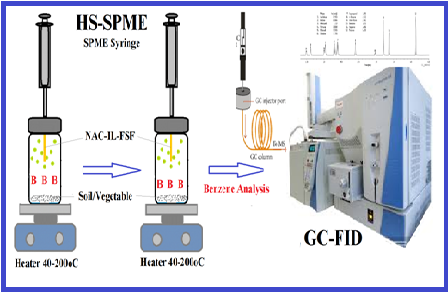Benzene extraction in environmental samples based on the mixture of nanoactivated carbon and ionic liquid coated on fused silica fiber before determination by headspace solid-phase microextraction-gas chromatography
Volume 4, Issue 01, Pages 68-78, Mar 2021 *** Field: Analytical Chemistry
Abstract
In this study, the mixture of nano activated carbon (NAC) and ionic liquid (3-triphenylphosphonio-propane-1-sulfonate; C21H21O3PS) was coated on fused silica fiber of SPME holder (NAC-IL-FSF/SPME). Then NAC/IL was used for determining of benzene in soil and vegetables samples (1.0 g, n=50) surrounding a chemical industry zone. After benzene adsorption on NAC-IL based on head space solid phase micoextraction (HS-SPME), the concentration of benzene was simply determined by introducing probe to injector of gas chromatography with flame-ionization detection (GC-FID). All effected parameters such as the sorbent mass, the amount of sample, the temperature, and the interaction time were optimized in glass chromatography vials by static procedures. The benzene vapor was absorbed from soil and vegetables samples with NAC-IL-FSF/SPME holder for 10 min at 80oC (10 mg of NAC and 0.1 g of ionic liquid in 0.5 mL of acetone coated on FSF). Then the benzene was desorbed and determined by GC-FID spectrometry. The extraction efficiency and absorption capacity of adsorbent were obtained 98.5% and 127.2 mg g-1, respectively. The high surface area of NAC and favorite interaction of aromatic chain in IL (π-π), caused to efficiently remove of benzene vapor by HS-SPME procedure as compared to other nanostructures.
References
S. Sun, Z. Zhao, J. Shen, Effects of the manufacturing conditions on the VOCs emissions of particleboard, Bioresour., 15 (2020) 1074–1084.
G.H. Li, W. Wei, X. Shao, L. Nie, H.L. Wang, A comprehensive classification method for VOCs emission sources to tackle air pollution based on VOCs species reactivity and emission amounts, J. Environ. Sci., 67 (2018) 78–88.
G.D. Thurston, Outdoor air pollution: sources, atmospheric transport, and human health effects, international encyclopedia of public health, 2nd ed., Elsevier: Cambridge, MA, USA, 5 (2017) 367–377.
A.R. Schnatter, DC. Glass, G. Tang, RD. Irons, L. Rushton, Myelodysplastic syndrome and benzene exposure among petroleum workers: an international pooled analysis, J. Natl. Cancer Inst., 104 (2012) 1724-1737.
K. Zhou, QG. Zhang, GL. Han, AM. Zhu, L. Liu, Pervaporation of water–ethanol and methanol–MTBE mixtures using poly (vinyl alcohol)/cellulose acetate blended membranes, J. Membrane Sci., 448 (2013) 93-101.
J.E. Chang, D.S. Lee, S.W. Ban, J. Oh, M.Y. Jung, S.H. Kim, S.J. Park, K. Persaud, S. Jheon, Analysis of volatile organic compounds in exhaled breath for lung cancer diagnosis using a sensor system, Sens. Actuators B Chem., 255 (2018) 800–807.
Y. Sun, Y. Chen, C. Sun, H. Liu, Y. Wang, X. Jiang, Analysis of volatile organic compounds from patients and cell lines for the validation of lung cancer biomarkers by proton-transfer-reaction mass spectrometry, Anal. Methods, 11 (2019) 3188–3197.
J. Rudnicka, T. Kowalkowski, B. Buszewski, Searching for selected VOCs in human breath samples as potential markers of lung cancer, Lung Cancer, 135 (2019) 123–129.
T. Ahmad Mir, S. Ibrahim Wani, Early detection of lung cancer biomarkers through biosensor technology: a review, J. Pharm. Biomed. Anal., 164 (2019) 93–103.
M. Aivalioti, I. Vamvasakis, E. Gidarakos, BTEX and MTBE adsorption onto raw and thermally modified diatomite, J. Hazard. Mater., 178 (2010) 136-143.
International Agency for Research on Cancer (IARC) monographs on the evaluation of carcinogenic risks to humans. overall evaluations of carcinogenicity, 1-42, 1987.
T.J. Lentz, M. Seaton, P. Rane, S.J. Gilbert, L.T. McKernan, C. Whittaker, Technical Report: the NIOSH occupational exposure banding process for chemical risk management, US, 2019.
S. KP Veerapandian, N. De Geyter, J.M. Giraudon, J.F. Lamonier, R. Morent, The use of zeolites for VOCs abatement by combining non-thermal plasma, adsorption, and/or catalysis: a review, Catalysts, 9 (2019) 98.
J.M.M.D. Mello, H. deLimaBranda, A.A.U. deSouza, A. daSilva, Biodegredation of BTEX compounds in a biofilm reactor-Modeling and simulation, J. Petrol. Sci. Eng., 70 (2010) 131–139.
S. Teimoori, A. Hessam Hassani, M Panaahie, Extraction and determination of benzene from waters and wastewater samples based on functionalized carbon nanotubes by static head space gas chromatography mass spectrometry, Anal. Method Environ. Chem. J. 3 (1) (2020) 17-26.
M.J. Lashaki, J.D. Atkinson, Z. Hashisho, J.H. Phillips, J.E. Anderson, M. Nichols, The role of beaded activated carbon’s pore size distribution on heel formationduring cyclic adsorption/desorption of organic vapors, J. Hazard. Mater., 315(2016) 42–51.
L. Mohammadi, E. Bazrafshan, M. Noroozifar, A. Ansari-Moghaddam, F. Barahuie, D. Balarak, Adsorptive removal of benzene and toluene from aqueous environments by cupric oxide nanoparticles: kinetics and isotherm studies, J. Chem., 2017 (2017) 1-10. https://doi.org/10.1155/2017/2069519
J. Cheng, L. Li, Y. Li, Q. Wang, C. He, Fabrication of pillar arene-polymer-functionalized cotton ibers as adsorbents for adsorption of organic pollutants in water and volatile organic compounds in air, Cellulose, 26 (2019) 3299- 3312.
R. Ashouri, H. Shirkhanloo, A.M. Rashidi, SA.H. Mirzahosseini, N. Mansouri, Dynamic and static removal of benzene from air based on task-specific ionic liquid coated on MWCNTs by sorbent tube-headspace solid-phase extraction procedure, Int. J. Environ. Sci. Technol., (2020) 1-14. https://doi.org/10.1007/s13762-020-02995-4
M. Mao, Y. Li, J. Hou, M. Zeng, X. Zhao, Extremely efficient full solar spectrum light driven thermocatalytic activity for the oxidation of VOCs on OMS-2 nanorod catalyst, Appl. Catal. B, 174 (2015) 496-503.
I. Ghouma, M. Jeguirim, S. Dorge, L. Limousy, C. Matei Ghimbeu, A. Ouederni, Activated carbon prepared by physical activation of olive stones for the removal of NO2 at ambient temperature, Comptes Rendus Chim., 18 (2015) 63-74.
O. Yahya Bakather, Adsorption of benzene on impregnated carbon nanotubes, Ain Shams Eng. J., 11 (2020) 905-912.
M. Bagheri, H. Shirkhanloo, J. Rakhtshah, Air pollution control: The evaluation of TerphApm@ MWCNTs as a novel heterogeneous sorbent for benzene removal from air by solid phase gas extraction, Arab. J. Chem., 13 (2020) 1741-1751.
Y. Liu, J. Zhang, X. Chen, J. Zheng, G. Wang, and G. Liang, Insights into the adsorption of simple benzene derivatives on carbon nanotubes, RSC Adv., 4 (2014) 58036-58046.
Y. Kan, Q. Yue, B. Gao, Q. Li, Preparation of epoxy resin-based activated car-bons from waste printed circuit boards by steam activation, Mater. Lett., 159 (2015) 443-446.
J.M. Valente Nabais, P.J.M. Carrott, MM.L. Ribeiro Carrott, J.A. Menéndez, Preparation and modification of activated carbon by microwave heating, Carbon, 42 (2004)1315-20.

Copyright (c) 2021 Analytical Methods in Environmental Chemistry Journal

This work is licensed under a Creative Commons Attribution 4.0 International License.
JOURNAL PUBLISHING AGREEMENT
PLEASE PROVIDE US THE FOLLOWING INFORMATION,
Article entitled:
Corresponding author:
To be published in the journal:
Your Status
I am the sole author of the manuscript
- I am an Iranian government employee.
- I am a European government employee
- I am a Asian government
- None of the above
I am one author signing on behalf of all co-authors of the manuscript
- I am an Iranian government employee.
- I am a European government employee
- I am a Asian government
- None of the above
Please tick the above blanks (as appropriate), review the Journal Publishing Agreement, and then sign and date the document in black ink.
Published Journal Article: the author may share a link to the formal publication through the relevant DOI. Additionally theses and dissertations which contain embedded Published Journal Articles as part of the formal submission may be hosted publicly by the awarding institution with a link to the formal publication through the relevant DOI. Any other sharing of Published Journal Articles is by agreement with the publisher only.
Signed: ______________________________________ Name printed: ___________________________________________
Title and Company (if employer representative): _______________________Date: __________________________________














